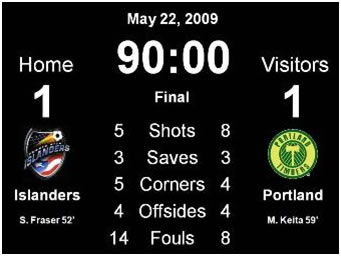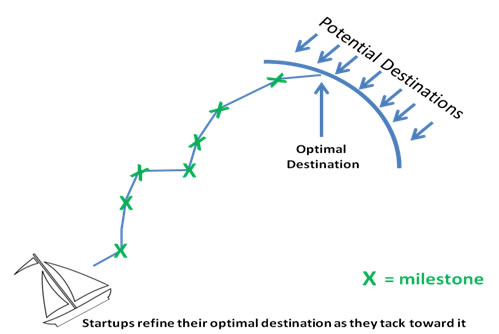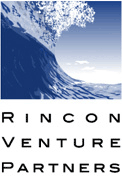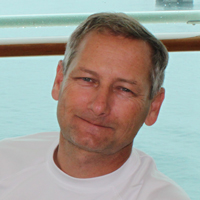 A friend once told me about a soccer game in which the opposing team deployed a frustratingly effective strategy. Every time they scored, their Captain ran around the field yelling, “tied score, tied score!” He continued to do this, despite the fact that they were beating my friend’s team by several goals.
A friend once told me about a soccer game in which the opposing team deployed a frustratingly effective strategy. Every time they scored, their Captain ran around the field yelling, “tied score, tied score!” He continued to do this, despite the fact that they were beating my friend’s team by several goals.
The Captain’s message was clear, “Ignore the score and play as if we are tied. If we sustain the intensity of a tied game, we are assured victory.”
Entrepreneurs should maintain a like level of enthusiasm when operating their adVentures. If you always execute as if the score were tied, irrespective of the actual numbers your adVenture is putting on the scoreboard, your chances of success will be greatly enhanced.
If you haven't already subscribed yet, subscribe now for
free weekly Infochachkie articles!
Optimistic About Tomorrow, Pessimistic About Today
Not surprisingly, entrepreneurs tend to be more optimistic than the general populace. However, as described in Are You An Entrepreneur?, such optimism is not unbridled nor is it Pollyannish. It is coupled with an ostensibly incongruent pessimism regarding the achievement of near-term tasks.
Successful entrepreneurs have the ability to be optimistic about their long-term success while simultaneously apprehensive about their near-term failure. Just like the Captain of the soccer team, they are imminently confident they will ultimately win the game, but they are nervous about the outcome of the next few minutes, days and weeks.
Startup Strategy
In preparing for battle, I have found that planning is essential, but plans are useless.
Dwight Eisenhower, US General and former President
Strategic planning at a startup is guided by entrepreneurs’ innate optimistic pessimism. A startup’s overall goal is to survive until such time as it can ultimately thrive. The development of a detailed strategic plan is irrelevant, as the specific actions required to achieve this overarching goal are unclear and will ultimately be determined over time, based on exogenous circumstances and on-the-job learning.
Startup CEOs are akin to sailboat captains. Both operate exposed to the elements, surrounded by a handful of dedicated people, all of whom have a hands-on impact on the company’s / boat’s direction. In addition, the Captain and crew have a sense of ownership to their company / vessel and they know its operations intimately.
Rather than establish an extensive plan detailing how they will reach their destination, the crew simply aligns their ship with a distant point on the horizon. As it is wind powered, it is impossible to propel the ship in a linear path to the proposed destination. The startup CEO must tack and change the direction of the sailboat by pointing its bow into the wind. The process tends to result in a zigzag pattern as the Captain makes slight adjustments to address the vagaries of the shifting wind, waves and currents. However, the ship’s general direction remains relatively unwavering.

Conversely, a Big Dumb Company (BDC) CEO is analogous to the Captain of a supertanker. She is ensconced in a sophisticated bridge, hundreds of feet above the waves, surrounded by thousands of co-workers, reams of data and expensive technology. After extensive deliberation and planning, the supertanker’s destination is plotted and the ship burns an inordinate amount of fuel as it travels in a linear direction, irrespective of the wind, waves or currents. Even though the Captain and crew generally do not own the BDC ship, they must be as concerned about its safety as they are about reaching the appointed destination.

Making numerous, small course corrections, based on data learned from your customers, is a more effective go-to-market approach than investing time and energy into establishing a grand plan that is dogmatically executed and likely to be outdated by the time it is implemented. The effectiveness of this organic, “sailboat” approach has been well documented in a number of books, including Steven Blank’s The Four Steps to the Epiphany.
Before They Were Fab
When they were just four spotty faced teenagers in Liverpool, the Beatles shared a common vision. Their goal was huge and beyond naive. They wanted to become “bigger than Elvis.”
Although the Beatles had an outlandishly grand plan, they took a very pragmatic and incremental approach. According to John Lennon, their strategy was simple. First they focused on becoming popular in Hamburg, then on becoming the biggest band in Liverpool. They then hit the road and established a following in Northern England, before moving on to London. Once they conquered London, they then toured Europe and eventually became the most popular band in America. By tacking their way through the pop music landscape, they effectively became “bigger than Elvis.”
One of the milestones of the Beatles’ journey was an extended stint as the house band in a series of seedy Hamburg nightclubs. The first night they performed in Hamburg, the club was empty. Rather than wait for an audience to appear, according to Paul, they went outside the club and, “…were like carnival barkers. We’d grab two people and do whatever they wanted – our whole repertoire…we do all the jokes and try to be marvelous and make them want to come back.” Their initial lack of success in Hamburg did not dampen their vision of being “bigger than Elvis.” They viewed each gig as an opportunity to improve as opposed to a hardship that must persevered.
 The crowd for the Beatles first show in London was especially disappointing. Yet, despite the fact that only 18 people showed up, the Beatles were undeterred. Rather than giving the small crowd a lackluster performance, the Beatles used the opportunity to “play as if they were tied.”. They gave the modest audience the same level of energy and enthusiasm they would eventually give to over 50,000 fans at New York’s Shea Stadium. Despite the small audience, their first London show was so well received that a number of the attendees went clubbing with the Beatles after the show, drinking late into the night.
The crowd for the Beatles first show in London was especially disappointing. Yet, despite the fact that only 18 people showed up, the Beatles were undeterred. Rather than giving the small crowd a lackluster performance, the Beatles used the opportunity to “play as if they were tied.”. They gave the modest audience the same level of energy and enthusiasm they would eventually give to over 50,000 fans at New York’s Shea Stadium. Despite the small audience, their first London show was so well received that a number of the attendees went clubbing with the Beatles after the show, drinking late into the night.
The Beatles’ healthy pessimism motivated them to take nothing for granted. For instance, when the Beatles landed at JFK airport for their first US visit the band thought that the thousands of fans that they saw out of their airplane window were there to see the US President land.
Consider the following quotes, which describe the Beatles’ pessimism regarding their arrival in America, each illustrating the extent to which they realized that their prior accomplishments were meaningless in the face of their latest challenge:
PAUL: “George was the only one of us who’d been (to America) before and he’d been into record shops there and asked, ‘Have you got the Beatles’ records?’…but nobody had them, or had even heard of us. He came back and said, “They don’t know us, its going to be hard.’ We were used to being famous by then so we were worried about that.”
JOHN: “We didn’t think we stood a chance.”
“At first we had no idea, then we got the first couple of hits we thought, ‘Well, this is it, we’ll probably flop now.’”
“The thing is, in America, it just seemed ridiculous – I mean, the idea of having a hit record over there…but then I realized that kids everywhere all go for the same stuff, and seeing what we’d done in England, there’s no reason we couldn’t do it in America too.”
“I know on the plane over I was thinking, ‘Oh, we won’t make it,’ but that’s the (pessimistic) side of me: we knew we could wipe them out if we could just get a grip.”
Without realizing it, the Beatles followed the business axiom “inch by inch it’s a synch.” Like the entrepreneurial sailboat Captain, they selected a distant landmark as their destination and then incrementally created a detailed road-map of the near-term steps required to reach the next milestone. They never lost sight of their ultimate goal, yet they remained pessimistic about their ability to meet the next challenge.
You may not sell hundreds of millions of songs, but if you always ignore the score and pretend that you are tied, you will significantly increase your adVenture’s chances of success, while having a heck of a lot of fun in the process.
______________________
John Greathouse has held a number of senior executive positions with successful startups during the past fifteen years, spearheading transactions which generated more than $350 million of shareholder value, including an IPO and a multi-hundred-million-dollar acquisition.
John is a CPA and holds an M.B.A. from the Wharton School. He is a member of the University of California at Santa Barbara’s Faculty where he teaches several entrepreneurial courses.
______________________
Copyright © 2007-11 by J. Meredith Publishing. All rights reserved.




Pingback: Quora
Pingback: Quora
Pingback: ConTraps Part III - Contract Traps Entrepreneurs Should Avoid At All Costs
Pingback: Startup Children – How To Parent An Entrepreneur (Part II)
Pingback: Ten Startup Tips From Amazon Founder, Jeff Bezos
Pingback: Quora
Pingback: When Hiring Entrepreneurs, Ignore Their Resumes
Pingback: Eleven Startup Tips From Mark Cuban
Pingback: More Startup Tips From The Beatles
Pingback: Student Pastor, Work With What You Got! | Austin McCann